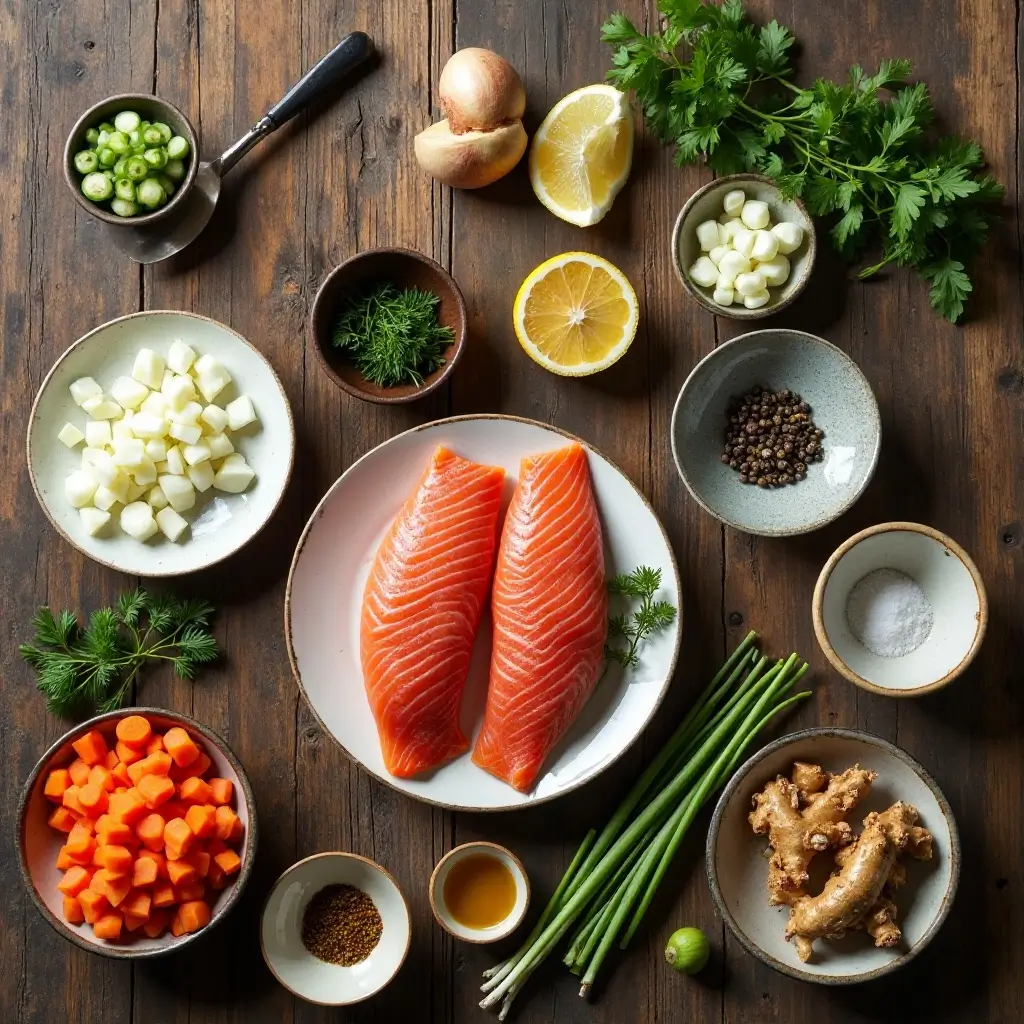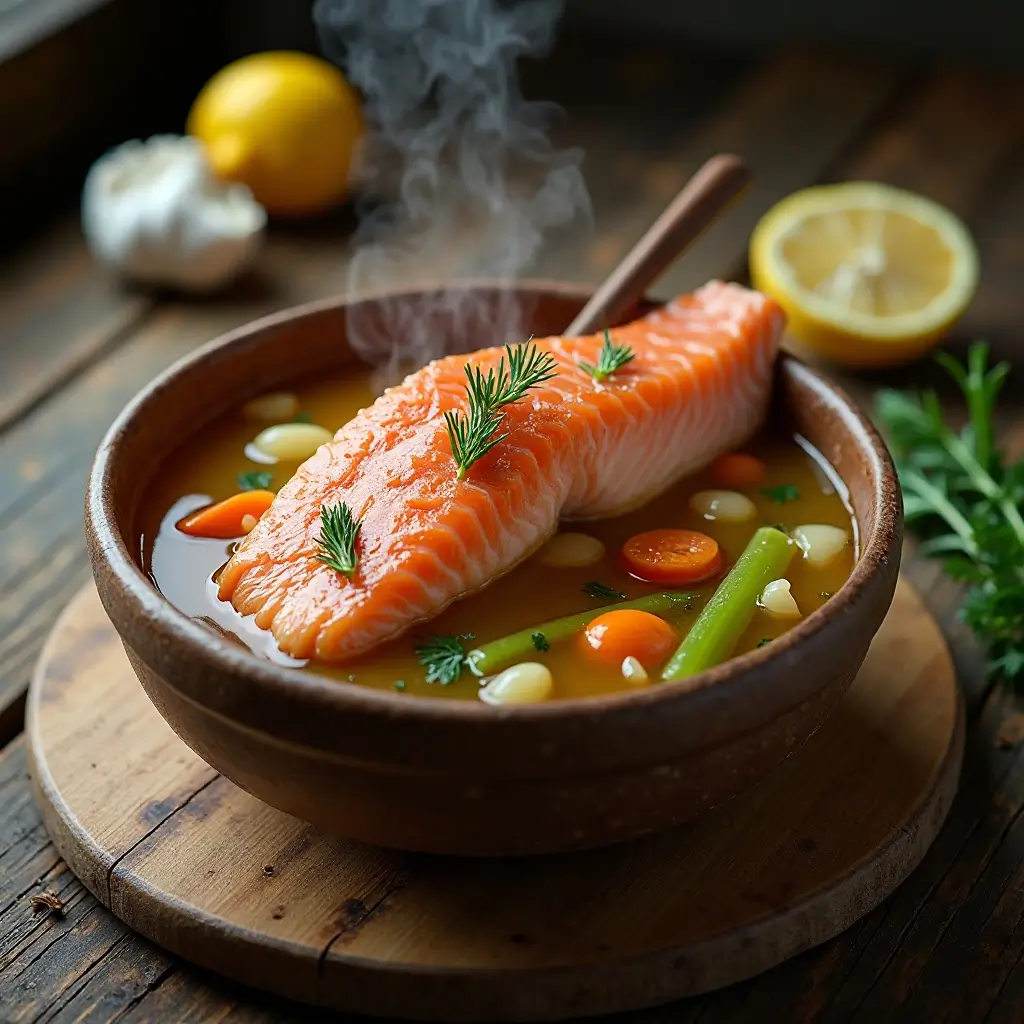Salmon Head Soup Easy Recipe
Picture this: a steaming bowl of rich, golden broth that’s been simmered to perfection, packed with tender meat and incredible flavor. This salmon head soup transforms what many consider “scraps” into a restaurant-quality dish that’ll have your family asking for seconds.
With its silky texture and deep, oceanic taste, this traditional recipe proves that the best flavors often come from unexpected places. Much like our popular fish bone broth recipe, this dish celebrates nose-to-tail cooking while delivering maximum nutrition and taste in just 45 minutes of hands-on time.
Table of Contents
What is Salmon Head Soup?
Ever wondered why this humble dish has such a straightforward name? Well, sometimes the best recipes don’t need fancy titles – they just need to deliver on flavor! Salmon head soup is exactly what it sounds like: a soul-warming broth made from salmon heads that would otherwise go to waste.
My grandmother always said “the way to a man’s heart is through his stomach,” and this recipe proves that the path doesn’t always require expensive cuts. Ready to discover why this simple soup has been a family favorite for generations?
Why You’ll Love This Salmon Head Soup
Rich, Restaurant-Quality Flavor at Home This salmon head soup delivers an incredibly rich, complex flavor that rivals expensive seafood restaurants. The salmon heads contain natural gelatin and oils that create a luxurious, silky broth with deep umami notes. Each spoonful offers tender pieces of salmon meat that fall off the bone, creating a satisfying and nourishing meal.
Budget-Friendly Gourmet Cooking Making salmon head soup at home saves you significant money compared to ordering seafood soup at restaurants. Salmon heads are often available at very low cost from fish markets or even free from fishmongers. This recipe transforms an inexpensive ingredient into a gourmet meal that feeds 4-6 people for just a fraction of restaurant prices.
Customizable with Flavorful Additions The beauty of this soup lies in its versatility. You can enhance it with fresh vegetables like carrots, celery, and onions, or add Asian-inspired ingredients like ginger, miso, and green onions. Similar to our popular seafood chowder recipe, this soup serves as a perfect base for your favorite seasonings and vegetables. Why not give this nutritious and delicious recipe a try in your own kitchen?
How to Make Salmon Head Soup
Quick Overview
This salmon head soup is surprisingly simple to make and incredibly satisfying. The key to success lies in properly cleaning the salmon heads and allowing enough time for the flavors to develop through slow simmering.
Prep Time: 15 minutes
Cook Time: 45 minutes
Total Time: 1 hour
Serves: 4-6 people
The rich, gelatinous broth develops naturally from the collagen in the salmon heads, creating a restaurant-quality texture without any artificial thickeners.
Key Ingredients for Salmon Head Soup
Main Ingredients:
- 2-3 large salmon heads (about 2 lbs), cleaned and gills removed
- 8 cups cold water
- 1 large onion, quartered
- 2 carrots, roughly chopped
- 2 celery stalks, roughly chopped
- 3 cloves garlic, smashed
Seasonings & Aromatics:
- 2 bay leaves
- 1 tablespoon whole peppercorns
- 1 teaspoon salt (adjust to taste)
- 2 tablespoons fresh dill
- 1 lemon, juiced
- 2 tablespoons olive oil
Optional Additions:
- 1 inch fresh ginger, sliced
- 2 tablespoons miso paste
- Green onions for garnish
- Fresh parsley for serving

Step-by-Step Instructions
Step 1: Prepare the Salmon Heads Rinse the salmon heads thoroughly under cold water. Remove any remaining gills, scales, and blood. Pat dry with paper towels. This cleaning step is crucial for achieving a clear, clean-tasting broth.
Step 2: Sauté the Aromatics Heat olive oil in a large pot over medium heat. Add onions, carrots, and celery. Cook for 5-7 minutes until vegetables begin to soften and become fragrant. Add garlic and cook for another minute.
Step 3: Add Salmon Heads and Water Place the cleaned salmon heads in the pot with the vegetables. Pour in cold water, ensuring the heads are completely covered. Add bay leaves, peppercorns, and salt.
Step 4: Bring to a Simmer Bring the mixture to a gentle boil over medium-high heat. Once boiling, reduce heat to low and maintain a gentle simmer. Skim off any foam or impurities that rise to the surface during the first 10 minutes.
Step 5: Simmer and Develop Flavor Continue simmering for 35-40 minutes, partially covered. The broth should develop a rich, golden color and the meat should easily pull away from the bones.
Step 6: Strain and Finish Remove the salmon heads and strain the broth through a fine-mesh sieve. Pick out any tender salmon meat from the heads and return it to the strained broth. Stir in fresh dill and lemon juice. Taste and adjust seasoning as needed.
What to Serve Salmon Head Soup With
This hearty soup pairs beautifully with crusty sourdough bread or warm dinner rolls for dipping. Serve alongside a fresh green salad with cucumber and tomatoes to balance the rich broth. For a complete meal, consider adding cooked rice or noodles directly to the soup bowls.
A crisp white wine like Sauvignon Blanc or Pinot Grigio complements the soup’s oceanic flavors perfectly. For non-alcoholic options, try sparkling water with lemon or a light herbal tea.
Top Tips for Perfecting Salmon Head Soup
Choose Quality Salmon Heads
Select fresh salmon heads from a reputable fishmonger. The eyes should be clear, and the gills should be bright red. Fresh heads produce the best-tasting broth with optimal nutritional benefits.
Don’t Rush the Simmering Process
Low and slow is the key to extracting maximum flavor and creating that signature silky texture. Rapid boiling will make the broth cloudy and can make the fish meat tough.
Strain Thoroughly for Clarity
Use a fine-mesh strainer lined with cheesecloth for the clearest broth. This removes any small bones or particles, ensuring a smooth, restaurant-quality presentation.
Season at the End
Add salt and acid (lemon juice) at the end of cooking to brighten the flavors without interfering with the natural extraction process during simmering.

Storing and Reheating Tips
Refrigerator Storage: Store leftover salmon head soup in the refrigerator for up to 3 days in airtight containers. The broth may solidify due to natural gelatin – this is normal and indicates a well-made stock.
Freezing Instructions: Freeze the soup for up to 3 months in freezer-safe containers, leaving 1 inch of headspace for expansion. Freeze in portion-sized containers for easy reheating.
Reheating Methods: Reheat gently on the stovetop over low heat, stirring occasionally. Avoid microwaving at high power, which can make the fish meat rubbery. For frozen soup, thaw overnight in the refrigerator before reheating.
Pro Tip: If the soup becomes too thick after refrigeration, simply add a little water or additional broth when reheating to achieve your desired consistency.
Nutrition Information
| Nutrient | Per Serving (1 cup) |
|---|---|
| Calories | 120 |
| Protein | 18g |
| Fat | 4g |
| Carbohydrates | 3g |
| Fiber | 1g |
| Sodium | 480mg |
| Omega-3 Fatty Acids | 850mg |
| Vitamin D | 15% DV |
| Calcium | 8% DV |
Frequently Asked Questions
Where can I buy salmon heads?
Most fish markets and some grocery stores with full-service seafood counters sell salmon heads. Call ahead to ensure availability, or ask your fishmonger to save them for you. Asian markets often carry salmon heads regularly.
Can I use frozen salmon heads?
Yes, frozen salmon heads work well for this recipe. Thaw them completely in the refrigerator before use and follow the same cleaning and preparation steps as fresh heads.
How do I know when the soup is done?
The soup is ready when the broth has a rich, golden color and the salmon meat easily separates from the bones. This typically takes 35-45 minutes of gentle simmering.
Can I make this soup in a slow cooker?
Absolutely! Brown the vegetables first, then transfer everything to a slow cooker. Cook on low for 6-8 hours or high for 3-4 hours. Strain and finish as directed.
Is salmon head soup healthy?
Yes, salmon head soup is incredibly nutritious. It’s rich in omega-3 fatty acids, high-quality protein, collagen, and essential minerals like calcium and phosphorus.
Can I add vegetables to the soup?
Certainly! Add diced potatoes, corn, or leafy greens during the last 10 minutes of cooking. Root vegetables like turnips or parsnips also work wonderfully.
This traditional salmon head soup recipe proves that the most satisfying meals often come from simple, honest ingredients. By utilizing the entire fish, you’re not only creating an incredibly flavorful and nutritious meal but also practicing sustainable cooking that reduces waste. Give this recipe a try, and discover why salmon head soup has been warming hearts and homes for generations!
